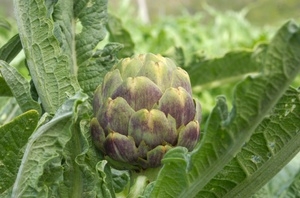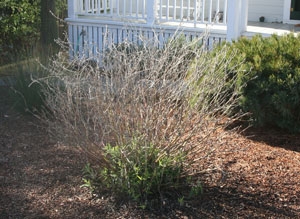
There are a number that do well in our climate once established, such as asparagus, artichokes, rhubarb, horseradish and watercress.
There are others that are often grown as annuals but will return in our mild climate and can be grown as perennials such as kale, garlic and radicchio.
It may take a little work to get some of them going, such as asparagus, but you will be rewarded with many years of fresh vegetables from the same plants year in and year out. And just think how unique you will be with your homemade horseradish sauce to share with your friends instead of salsa or zucchini bread!

There should be a significant amount of basal growth at their bases to allow the tall, rangy stems to be cut off without harming the plant.
If you don't prune them now they will get woody and tend to flop over on neighboring plants. Do not prune perennials that bloom in the spring, such as lavender and yarrow and or you will remove the buds and you won't have any flowers in the upcoming months.A good rule of thumb is to always prune after a plant has bloomed.
Once they have been pruned, a dose of fertilizer and a good mulching and they are good to go for another season!

- UC Food Observer: For policy wonks to the public at large, UC Food Observer is your daily selection of must-read news from the world of food, developed by the University of California as part of the UC Global Food Initiative. The UC Food Observer blog (www.ucfoodobserver.com) and related social media channels aim to highlight important news and add value to the varied discussions occurring about how to sustainably and nutritiously feed the world. Find out more in this news release and in this Q&A with UC Food Observer curator Rose Hayden-Smith, a UC academic and author.
- UC Global Food Initiative landing page: The UC Global Food Initiative landing page is an online storytelling site for news and events about the Global Food Initiative. The Web page is meant to be the public-facing site for the Global Food Initiative. It will highlight the latest news around the initiative from the campuses and UCOP, such as the recent California Higher Education Food Summit. You can find news stories, features, videos, podcasts, media coverage, a calendar of events and promotion boxes linking to the UC Food Observer blog and related social media. The Web page (http://
universityofcalifornia.edu/ global-food-initiative), which complements the existing administrative-focused GFI page on UCOP.edu, is part of an iterative process that will evolve as the initiative progresses.

Bringing the plants that are in containers into a covered area is the ideal way to protect them, otherwise covering them with sheets or stringing lit low voltage Christmas lights through them will help fend off the damage for a few nights.
Once the frost has hit though and the leaves have turned black and limp, it is best just to leave them on the plant until all threats of frost are gone - which could be a few months. Otherwise you may encourage new growth by trimming off the dead foliage and that will be damaged even more and deeper into the plant if there is another round of frost in the future.
It is best to sacrifice a few months of unsightly black foliage that will act as a shield than to lose a plant entirely. You can check the almanac for the last frost dates by zip code for your area.



